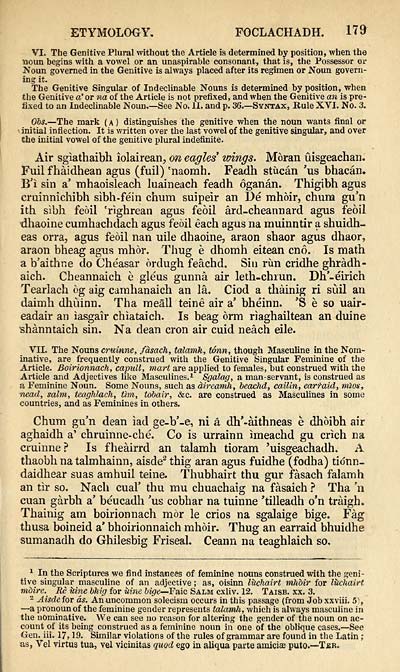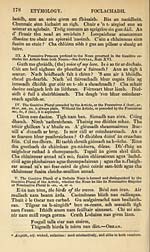Books and other items printed in Gaelic from 1841 to 1870 > Stéidhean a' Ghràmair Ghaëlig
(207) Page 179
Download files
Complete book:
Individual page:
Thumbnail gallery: Grid view | List view

ETYMOLOGY.
FOCLACHADH. 17 £
VI. The Genitive Plural without the Artiele is determined by position, when the
noun begins with a vowel or an unaspirable consonant, that is, the Possessor or
Noun governed in the Genitive is always placed after its regimen or Noun govern-
ing it.
The Genitive Singular of Indeclinable Nouns is determined by position, when
the Genitive a' or na of the Article is not prefixed, and when the Genitive an is pre-
fixed to an Indeclinable Noun.— See No. II. and p. 36.— Syntax, Rule XVI. No. 3.
Obs.— The mark ( a ) distinguishes the genitive when the noun wants final or
initial infiection. It is written over the last vowel of the genitive singular, and over
the initial vowel of the genitive plural indefinite.
Air sgìathaibh ìolairean, on eagles' wings. Mòran ùisgeachan.
Fuil f hàidhean agus (fuil) c naomh. Feadh stùcàn 'us bhacàn.
B'ì sin a' mhaoisleach luaineach feadh òganàn. Thigibh agus
cruinnichibh sìbh-fèin chum suipeìr an Dè mhòir, chum gu'n
ith sìbh feòil 'rìghrean agus feòil àrd-cheannard agus feòil
dhaoine cumhachdach agus feòil èach agus na muinntir a shuidh-
eas orra, agus feòil nan uile dhaoine, araon shaor agus dhaor,
araon bheag agus mhòr. Thug è dhomh eitean cnò. Is math
a b'aithne do Chèasar òrdugh feàchd. Siti rùn cridhe ghràdh-
aich. Cheannaich è glèus gunnà air leth-chrun. Dh'-èirich
Tearlach òg aig camhanaich an là. Ciod a thàinig ri sùil an
daimh dhùinn. Tha meàll teinè air a' bhèinn. 'S è so uair-
eadair an ìasgaìr chìataich. Is beag òrm rìaghailtean an duine
shànntaich sin. Na dean cron air cuid neàch eile.
VII. The Nouns cruinne, fàsach, taiamk, tònn, though Masculine in the Nom-
inative, are frequently construed with the Genitive Singular Feminine of the
Article. Boirionnach, capull, mart are applied to females, but construed with the
Article and Adjectives like Masculines. 1 Sgalag, a man-servant, is construed as
a Feminine Noun. Some Nouns, such as àireamh, beachd, cailin, eartaid, mlos,
nead, salm, teaghlach, tìm, tobair, &c. are construed as Masculines in some
countries, and as Feminines in others.
Chum gu'n dean ìad ge-b'-e, ni à dh'-àithneas è dhòibh air
aghaidh a' chruinne-chè. Co is urrainn ìmeachd gu crìch na
cruinne? Is fheàirrd an talamh tioram 'uisgeachadh. A
thaobh na talmhainn, aisde 2 thig aran agus fuidhe (fodha) tidnn-
daidhear suas amhuil teine. Thubhairt thu gur fàsach falamh
an tìr so. Nach cual' thu mu chuachaig na fàsaich ? Tha 'n
cuan gàrbh a' bèucadh 'us cobhar na tuinne 'tilleadh o'n tràigh.
Thainig am boirionnach mòr le crios na sgalaige bige. Fàg
thusa boineid a' bhoirionnaich mhòir. Thug an earraid bhuidhe
sumanadh do Ghilesbig Friseal. Ceann na teaghlaich so.
1 In the Scriptures we find instauees of feminine nouns construed with the geni-
tive singular masculine of an adjective ; as, oisinn làchairt mhòir for Ihchairt
mòire^ Rè àine bhig for ùine bige—Faxc Salm cxliv. 12. Taisb. xx. 3.
2 Aisdefor às. Anuncommon solecism occurs in this passage (from Jobxxviii. 51,
— a pronounof the feminine gender represents talamJi, which is always masculine in
the nominative. We can see no reason for altering the gender of the noun on ac-
count of its being construed as a i'eminine noun in one of the oblkjue cases. — See
Gen. iii. 17, 1.9. Similar violations of the rules of grammar are found in the Latin ;
as, Vel virtus tua, vel vicinitas quod ego in aliqua parte amicise puto.— Tbr.
FOCLACHADH. 17 £
VI. The Genitive Plural without the Artiele is determined by position, when the
noun begins with a vowel or an unaspirable consonant, that is, the Possessor or
Noun governed in the Genitive is always placed after its regimen or Noun govern-
ing it.
The Genitive Singular of Indeclinable Nouns is determined by position, when
the Genitive a' or na of the Article is not prefixed, and when the Genitive an is pre-
fixed to an Indeclinable Noun.— See No. II. and p. 36.— Syntax, Rule XVI. No. 3.
Obs.— The mark ( a ) distinguishes the genitive when the noun wants final or
initial infiection. It is written over the last vowel of the genitive singular, and over
the initial vowel of the genitive plural indefinite.
Air sgìathaibh ìolairean, on eagles' wings. Mòran ùisgeachan.
Fuil f hàidhean agus (fuil) c naomh. Feadh stùcàn 'us bhacàn.
B'ì sin a' mhaoisleach luaineach feadh òganàn. Thigibh agus
cruinnichibh sìbh-fèin chum suipeìr an Dè mhòir, chum gu'n
ith sìbh feòil 'rìghrean agus feòil àrd-cheannard agus feòil
dhaoine cumhachdach agus feòil èach agus na muinntir a shuidh-
eas orra, agus feòil nan uile dhaoine, araon shaor agus dhaor,
araon bheag agus mhòr. Thug è dhomh eitean cnò. Is math
a b'aithne do Chèasar òrdugh feàchd. Siti rùn cridhe ghràdh-
aich. Cheannaich è glèus gunnà air leth-chrun. Dh'-èirich
Tearlach òg aig camhanaich an là. Ciod a thàinig ri sùil an
daimh dhùinn. Tha meàll teinè air a' bhèinn. 'S è so uair-
eadair an ìasgaìr chìataich. Is beag òrm rìaghailtean an duine
shànntaich sin. Na dean cron air cuid neàch eile.
VII. The Nouns cruinne, fàsach, taiamk, tònn, though Masculine in the Nom-
inative, are frequently construed with the Genitive Singular Feminine of the
Article. Boirionnach, capull, mart are applied to females, but construed with the
Article and Adjectives like Masculines. 1 Sgalag, a man-servant, is construed as
a Feminine Noun. Some Nouns, such as àireamh, beachd, cailin, eartaid, mlos,
nead, salm, teaghlach, tìm, tobair, &c. are construed as Masculines in some
countries, and as Feminines in others.
Chum gu'n dean ìad ge-b'-e, ni à dh'-àithneas è dhòibh air
aghaidh a' chruinne-chè. Co is urrainn ìmeachd gu crìch na
cruinne? Is fheàirrd an talamh tioram 'uisgeachadh. A
thaobh na talmhainn, aisde 2 thig aran agus fuidhe (fodha) tidnn-
daidhear suas amhuil teine. Thubhairt thu gur fàsach falamh
an tìr so. Nach cual' thu mu chuachaig na fàsaich ? Tha 'n
cuan gàrbh a' bèucadh 'us cobhar na tuinne 'tilleadh o'n tràigh.
Thainig am boirionnach mòr le crios na sgalaige bige. Fàg
thusa boineid a' bhoirionnaich mhòir. Thug an earraid bhuidhe
sumanadh do Ghilesbig Friseal. Ceann na teaghlaich so.
1 In the Scriptures we find instauees of feminine nouns construed with the geni-
tive singular masculine of an adjective ; as, oisinn làchairt mhòir for Ihchairt
mòire^ Rè àine bhig for ùine bige—Faxc Salm cxliv. 12. Taisb. xx. 3.
2 Aisdefor às. Anuncommon solecism occurs in this passage (from Jobxxviii. 51,
— a pronounof the feminine gender represents talamJi, which is always masculine in
the nominative. We can see no reason for altering the gender of the noun on ac-
count of its being construed as a i'eminine noun in one of the oblkjue cases. — See
Gen. iii. 17, 1.9. Similar violations of the rules of grammar are found in the Latin ;
as, Vel virtus tua, vel vicinitas quod ego in aliqua parte amicise puto.— Tbr.
Set display mode to:
![]() Universal Viewer |
Universal Viewer | ![]() Mirador |
Large image | Transcription
Mirador |
Large image | Transcription
Images and transcriptions on this page, including medium image downloads, may be used under the Creative Commons Attribution 4.0 International Licence unless otherwise stated. ![]()
| Rare items in Gaelic > Books and other items printed in Gaelic from 1841 to 1870 > Stéidhean a' Ghràmair Ghaëlig > (207) Page 179 |
|---|
| Permanent URL | https://digital.nls.uk/101714083 |
|---|
| Description | Out-of-copyright books printed in Gaelic between 1631 and 1900. Also some pamphlets and chapbooks. Includes poetry and songs, religious books such as catechisms and hymns, and different editions of the Bible and the Psalms. Also includes the second book ever published in Gaelic in 1631. |
|---|

